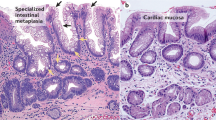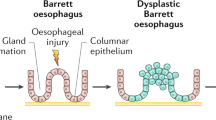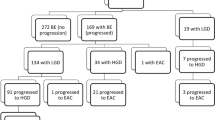Abstract
The pathogenesis of cancer in Barrett's esophagus is multifactorial. Gastroesophageal reflux seems to be important in the initiation of Barrett's esophagus, but its role in promoting carcinogenesis has yet to be established. Diet, lifestyle and carcinogens, especially the nitrates, may be important in the development of carcinogenesis, and require further investigation. Inhibition of reflux-stimulated inflammatory changes, for example by inhibiting cyclooxygenase, holds promise for decreasing cancer progression. Similarly, dietary and lifestyle modification used in the management of reflux may also help to prevent the development of esophageal cancer. The molecular changes that are associated with the development of cancer in Barrett's esophagus offer several potential areas of intervention to prevent and manage esophageal cancer. Limiting cell growth, increasing apoptosis of damaged cells, limiting cell invasion and angiogenesis factors could be useful to accomplish this goal. Having a greater understanding of the pathogenesis of this condition can only help to develop more management options in the future.
This is a preview of subscription content, access via your institution
Access options
Subscribe to this journal
Receive 12 print issues and online access
$209.00 per year
only $17.42 per issue
Buy this article
- Purchase on Springer Link
- Instant access to full article PDF
Prices may be subject to local taxes which are calculated during checkout



Similar content being viewed by others
References
Cameron AJ (1997). Barrett's esophagus: does the incidence of adenocarcinoma matter? Am J Gastro 92: 193–194
Lagergren J et al. (1999) Symptomatic gastroesophageal reflux as a risk factor for esophageal adenocarcinoma. N Engl J Med 340: 825–831
Jankowski JA et al. (1999) Molecular evolution of the metaplasia-dysplasia-adenocarcinoma sequence in the esophagus. Am J Pathol 154: 965–973
Vaezi MF and Richter JE . (1995) Synergism of acid and duodenogastroesophageal reflux in complicated Barrett's esophagus. Surgery 117: 699–704
Spechler SJ et al. (2001) Long-term outcome of medical and surgical therapies for gastroesophageal reflux disease: follow-up of a randomized controlled trial. JAMA 285: 2331–2338
Caldwell MT et al. (1995) Ambulatory oesophageal bile reflux monitoring in Barrett's oesophagus. Br J Surg 82: 657–660
Goldstein SR et al. (1997) Development of esophageal metaplasia and adenocarcinoma in a rat surgical model without the use of a carcinogen. Carcinogenesis 18: 2265–2270
Kawaura Y et al. (2001) Immunohistochemical study of p53, c-erbB-2, and PCNA in barrett's esophagus with dysplasia and adenocarcinoma arising from experimental acid or alkaline reflux model. J Gastroenterol 36: 595–600
Nehra D et al. (1999) Toxic bile acids in gastro-oesophageal reflux disease: influence of gastric acidity. Gut 44: 598–602
Sontag SJ (1990) The medical management of reflux esophagitis. Role of antacids and acid inhibition. Gastroenterol Clin N Am 19: 683–712
Theisen J et al. (2000) Suppression of gastric acid secretion in patients with gastroesophageal reflux disease results in gastric bacterial overgrowth and deconjugation of bile acids. J Gastrointest Surg 4: 50–54
Kaur BS et al. (2000) Bile salts induce or blunt cell proliferation in Barrett's esophagus in an acid-dependent fashion. Am J Physiol Gastrointest Liver Physiol 278: G1000–1009
Zhang F et al. (2001) Duodenal reflux induces cyclooxygenase-2 in the esophageal mucosa of rats: evidence for involvement of bile acids. Gastroenterology 121: 1391–1399
Wilson KT et al. (1998) Increased expression of inducible nitric oxide synthase and cyclooxygenase-2 in Barrett's esophagus and associated adenocarcinomas. Cancer Res 58: 2929–2934
Souza RF et al. (2002) Acid exposure activates the mitogen-activated protein kinase pathways in Barrett's esophagus. Gastroenterology 122: 299–307
Buttar N et al. (2002) The effect of selective cyclooxygenase-2 inhibition in Barrett's esophagus epithelium: an in vitro study. J Natl Cancer Inst 94: 422–429
Nishigaki Y et al. (1996) Ursodeoxycholic acid corrects defective natural killer activity by inhibiting prostaglandin E2 production in primary biliary cirrhosis. Dig Dis Sci 41: 1487–1493
Wild CP and LJ Hardie (2003) Reflux, Barrett's oesophagus and adenocarcinoma: burning questions. Nat Rev Cancer 3: 676–684
Barrett MT et al. (1999) Evolution of neoplastic cell lineages in Barrett oesophagus. Nat Genetics 22: 106–109
Qiao D et al. (2001) Deoxycholic acid suppresses p53 by stimulating proteasome-mediated p53 protein degradation. Carcinogenesis 22: 957–964
Ohsawa T et al. (2002) Effects of three H2-receptor antagonists (cimetidine, famotidine, ranitidine) on serum gastrin level. Int J Clin Pharmacol Res 22: 29–35
Iwao T et al. (1995) Effects of omeprazole and lansoprazole on fasting and postprandial serum gastrin and serum pepsinogen A and C. Hepatogastroenterology 42: 677–682
Haigh CR et al. (2003) Gastrin induces proliferation in Barrett's metaplasia through activation of the CCK2 receptor. Gastroenterology 124: 615–625
Abdalla SI et al. (2004) Gastrin-induced cyclooxygenase-2 expression in Barrett's carcinogenesis. Clin Cancer Res 10: 4784–4792
Engel LS et al. (2003) Population attributable risks of esophageal and gastric cancers. J Natl Cancer Inst 95: 1404–1413
Chow WH et al. (1998) Body mass index and risk of adenocarcinomas of the esophagus and gastric cardia. J Natl Cancer Inst 90: 150–155
Lagergren J et al. (1999) Association between body mass and adenocarcinoma of the esophagus and gastric cardia. Ann Intern Med 130: 883–890
Calle EE and Kaaks R (2004) Overweight, obesity and cancer: epidemiological evidence and proposed mechanisms. Nat Rev Cancer 4: 579–591
Iravani S et al. (2003) Modification of insulin-like growth factor 1 receptor, c-Src, and Bcl-XL protein expression during the progression of Barrett's neoplasia. Hum Pathol 34: 975–982
Coppola D et al. (1994) A functional insulin-like growth factor I receptor is required for the mitogenic and transforming activities of the epidermal growth factor receptor. Mol Cell Biol 14: 4588–4595
Ye W et al. (2004) Helicobacter pylori infection and gastric atrophy: risk of adenocarcinoma and squamous-cell carcinoma of the esophagus and adenocarcinoma of the gastric cardia. J Natl Cancer Inst 96: 388–396
Weston AP et al. (2000) Prospective evaluation of the prevalence of gastric Helicobacter pylori infection in patients with GERD, Barrett's esophagus, Barrett's dysplasia, and Barrett's adenocarcinoma. Am J Gastroenterol 95: 387–394
Chow WH et al. (1998) An inverse relation between cagA+ strains of Helicobacter pylori infection and risk of esophageal and gastric cardia adenocarcinoma. Cancer Res 58: 588–590
Wu AH et al. (2003) Role of Helicobacter pylori CagA+ strains and risk of adenocarcinoma of the stomach and esophagus. Int J Cancer 103: 815–821
Jones AD et al. (2003) Helicobacter pylori induces apoptosis in Barrett's-derived esophageal adenocarcinoma cells. J Gastrointest Surg 7: 68–76
Gammon MD et al. (1997) Tobacco, alcohol, and socioeconomic status and adenocarcinomas of the esophagus and gastric cardia. J Natl Cancer Inst 89: 1277–1284
Mirvish SS (1997) Studies on experimental animals involving surgical procedures and/or nitrosamine treatment related to the etiology of esophageal adenocarcinoma. Cancer Lett 117: 161–174
Calmels S et al. (1999) Bacterial formation of N-nitroso compounds in the rat stomach after omeprazole-induced achlorhydria. IARC Sci Publ 1991: 187–191
Forman D et al. (1985) Nitrates, nitrites and gastric cancer in Great Britain. Nature 313: 620–625
Duncan C et al. (1995) Chemical generation of nitric oxide in the mouth from the enterosalivary circulation of dietary nitrate. Nat Med 1: 546–551
Spechler SJ (2002) Carcinogenesis at the gastroesophageal junction: free radicals at the frontier. Gastroenterology 122: 1518–1520
Liu RH and Hotchkiss JH (1995) Potential genotoxicity of chronically elevated nitric oxide: a review. Mutat Res 339: 73–89
Jankowski J et al. (1993) Increased expression of epidermal growth factor receptors in Barrett's esophagus associated with alkaline reflux: a putative model for carcinogenesis. Am J Gastroenterol 88: 402–408
Brito MJ et al. (1995) Association of transforming growth factor alpha (TGFA) and its precursors with malignant change in Barrett's epithelium: biological and clinical variables. Int J Cancer 60: 27–32
Barrett MT et al. (1996) Allelic loss of 9p21 and mutation of the CDKN2/p16 gene develop as early lesions during neoplastic progression in Barrett's esophagus. Oncogene 13: 1867–1873
Arber N et al. (1996) Increased expression of the cyclin D1 gene in Barrett's esophagus. Cancer Epidemiol, Biomarkers Prev 5: 457–459
Sarbia M et al. (1999) Expression of cyclin E in dysplasia, carcinoma, and nonmalignant lesions of Barrett esophagus. Cancer 86: 2597–2601
Boynton RF et al. (1991) Frequent loss of heterozygosity at the retinoblastoma locus in human esophageal cancers. Cancer Res 51: 5766–5769
Garrigue-Antar L et al. (1996) Loss of transforming growth factor-beta type II receptor gene expression in primary human esophageal cancer. Lab Invest 75: 263–272
Krishnadath KK et al. (2001) Biomarkers in Barrett esophagus. Mayo Clin Proc 76: 438–446
Younes M et al. (2000) Decreased expression of Fas (CD95/APO1) associated with goblet cell metaplasia in Barrett's esophagus. Hum Pathol 31: 434–438
Morales CP et al. (1998) In situ hybridization for the detection of telomerase RNA in the progression from Barrett's esophagus to esophageal adenocarcinoma. Cancer 83: 652–659
Dolan K et al. (1999) LOH at the sites of the DCC, APC, and TP53 tumor suppressor genes occurs in Barrett's metaplasia and dysplasia adjacent to adenocarcinoma of the esophagus. Hum Pathol 30: 1508–1514
Salmela MT et al. (2001) Upregulation and differential expression of matrilysin (MMP-7) and metalloelastase (MMP-12) and their inhibitors TIMP-1 and TIMP-3 in Barrett's oesophageal adenocarcinoma. Br J Cancer 85: 383–392
Couvelard A et al. (2000) Angiogenesis in the neoplastic sequence of Barrett's oesophagus. Correlation with VEGF expression. J Pathol 192: 14–18
Acknowledgements
The authors would like to acknowledge the support of the NIH and the Mayo Foundation.
Author information
Authors and Affiliations
Corresponding author
Rights and permissions
About this article
Cite this article
Buttar, N., Wang, K. Mechanisms of Disease: carcinogenesis in Barrett's esophagus. Nat Rev Gastroenterol Hepatol 1, 106–112 (2004). https://doi.org/10.1038/ncpgasthep0057
Received:
Accepted:
Issue Date:
DOI: https://doi.org/10.1038/ncpgasthep0057
This article is cited by
-
TGF-β is insufficient to induce adipocyte state loss without concurrent PPARγ downregulation
Scientific Reports (2020)
-
FOXO1 overexpression and loss of pSerine256-FOXO1 expression predicts clinical outcome in esophageal adenocarcinomas
Scientific Reports (2018)
-
Globular adiponectin inhibits leptin-stimulated esophageal adenocarcinoma cell proliferation via adiponectin receptor 2-mediated suppression of UHRF1
Molecular and Cellular Biochemistry (2017)
-
SOX2 as a Novel Marker to Predict Neoplastic Progression in Barrett’s Esophagus
American Journal of Gastroenterology (2015)
-
Predictors for Neoplastic Progression in Patients With Barrett's Esophagus: A Prospective Cohort Study
American Journal of Gastroenterology (2011)



